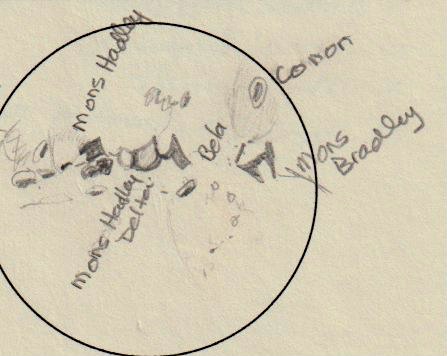IWLOP #070 - Montes Apenninus & Apennine Bench
Spectacular mountain range with heights to 5,000 metres; best seen at first and last quarter.
Location: 20.0 N - 10.0 W - 6.0 E Origin: Impact and Tectonic Length: 600 km (Monte Apenninus) Rukl: 22, 21 Type: Mount
Objects: Montes Apenninus, Apennine Bench, Mare Imbrium, Montes Carpatus, Montes Alpes, Mons Hadley, Mons Hadley Delta, Mons Bradley, Mons Huygens, Mons Ampère, Mons Wolf, Apollo 15 landing site
Others Identified: Bela, Conon, Vallis Alpes
Location: Home
Date: 2019-03-14
Time: 7:15 PM ADT
Equipment: 6" Dobsonian, 25 mm eyepiece + x2 Barlow
Magnification: x96
Seeing: Good (3)
Transparency: Good (3)
This observation was two days after First Quarter.
 |
R1: Located the full range of the Montes Apenninus that forms the southern Imbrium basin. C1: I located and sketched the northern portion of the mountain range that contained Mons Hadley, Mons Hadley Delta, and Mons Bradley. However, Mons Huygens, Mons Ampère, and Mons Wolf were also located and identified in the southern range. |
NOTES: (from a web search re definition of "Apennine Bench"):
"The term Apennine Bench Formation (ABF) was originally used to denote the diamond-shaped zone of relatively smooth, flat light-gray material that has high albedo (reflectance) situated roughly midway between Montes Apenninus and Archimedes and is somewhat larger than Archimedes in size. It has a unique "KREEPy" chemical signature. The acronym ‘KREEP’ is used to identify higher abundances of potassium (K), rare earth elements (REE), and phosphorus (P). By relative dating, we can tell that the ABF formed after the Imbrium basin impact event (around 3.85 billion years ago)and before Mare Imbrium – the massive lava deposit that erupted within the basin, filling it to about half its original depth. This stratigraphy (time order) tells us that the ABF could be an example of pre-mare volcanism, whose magma came from a different source than the later basaltic eruptions that cover about 30% of the nearside. Since its formation, the ABF has been modified by many impact craters."